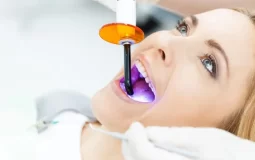Discover the different types of dental fillings to choose from, from composite resin fillings to porcelain, and find out their pros and cons.
When we experience tooth damage due to cavities or cavities, one of the most common solutions is to fill them. This process is not only to restore the function of the teeth, but also to maintain the aesthetic appearance of the damaged teeth. However, there are various types of dental fillings available with different materials and prices. Each type of dental filling has its own characteristics, and the choice depends on the patient’s clinical needs and aesthetic preferences.
Here is a more in-depth explanation of the different types of dental fillings available on the market, which can help you choose the best option for your dental condition.
1. Composite Resin Fillings

Composite resin fillings are one of the most widely used and recommended options by dentists. These fillings are made from a mixture of resin and glass powder that is inserted into the cavity of the tooth while it is still soft. After that, this material will be irradiated using a special light to harden and adjust to the shape of the tooth.
One of the main reasons why composite resin fillings are so popular is because they closely match the color of natural teeth. This makes them ideal for use on front teeth that are often seen. However, this type of Tooth Filling is not as strong as other types and usually only lasts about 5 to 10 years. Therefore, composite fillings need to be replaced within this time period to ensure that the quality and strength of the tooth remain optimal.
However, it should be noted that composite resin fillings are relatively more expensive compared to other types of fillings. However, for those who prioritize aesthetics and the appearance of natural teeth, this filling is the right choice.
2. Silver Dental Filling Material (Amalgam)
Amalgam fillings are dental filling materials made from a mixture of silver, mercury, tin, and copper. This type of filling is known for its incredible strength and ability to last a long time, even up to 12 years. Amalgam fillings are quite effective in treating large cavities and are often used for back teeth that are not clearly visible.
The advantage of amalgam fillings is that they are more affordable when compared to composite or porcelain fillings. In addition, the installation process is also easier and faster, thus reducing the risk of contamination by blood or saliva.
However, the downside of amalgam fillings is that they are dark in color, making them unsuitable for use on more visible front teeth. In addition, although the use of mercury in amalgam remains controversial, most studies show that the use of amalgam in dental practice is considered safe. In Indonesia, the use of amalgam has been banned since 2018 due to the mercury content that can be harmful to the environment.
3. Gold Patch
As the name suggests, gold fillings are made from a mixture of gold and other metals such as silver or palladium. This patch is renowned for its exceptional strength and resistance to corrosion. Gold is also a non-reactive material, so it is safer to use in the mouth. Not only that, gold fillings can last a very long time, even more than 15 years.
One of the main advantages of gold fillings is their excellent durability, as well as their ability to maintain their shape and size even after years of use. However, gold fillings have a fairly high price and are usually only available at certain dental clinics that have specialist services.
Gold fillings also don’t have the natural feel of composite resin or porcelain fillings, so they’re better suited to less visible back teeth.
4. Glass Ionomer Cement (GIC)
Glass ionomer cement (GIC) fillings are made from a mixture of acrylic and glass, which has the advantage of being able to release fluoride. This fluoride content can help prevent the formation of caries in teeth that have not yet been damaged. GICs also have the ability to match the color of natural teeth, making them more aesthetic than amalgam.
However, GICs are weaker than other types of fillings, and their durability usually only lasts a few years. However, GICs are often used for fillings on children’s teeth or as temporary fillings. For those looking for a temporary solution or wanting to protect their teeth from caries, these fillings can be a good choice.
5. Porcelain (Ceramic) Fillings

Porcelain or ceramic fillings are one type of filling that offers the best aesthetic beauty. Made from high-quality ceramic materials, porcelain fillings can mimic the color and texture of natural teeth very well. This makes them especially suitable for front teeth that are more visible.
In addition to the outstanding aesthetics, porcelain fillings are also extremely durable and stronger than GIC. However, these fillings are more susceptible to cracking if exposed to very high pressure. Therefore, porcelain fillings are usually used for teeth that are not exposed to much pressure, such as front teeth.
The main disadvantage of porcelain fillings is that they are quite expensive. However, for those who prioritize the natural and long-lasting appearance of their teeth, porcelain fillings remain an excellent choice.
Each type of dental filling has its own advantages and disadvantages, and the choice depends largely on the patient’s clinical needs and aesthetic preferences. Composite resin fillings are ideal for those who want aesthetic results, while amalgam fillings are better suited to back teeth that are not visible. Gold fillings offer incredible strength, but come at a higher price, while porcelain fillings provide the best appearance at a higher price.
Before deciding on the type of dental filling to use, it is highly recommended to consult a dentist. The dentist will help you determine the type of filling that best suits your dental condition, as well as considering aesthetic and functional factors for optimal results. If you are also considering Dental Braces, your dentist may assess whether fillings are needed before orthodontic treatment to ensure a stable foundation. By understanding the different types of dental fillings available, you can make the right decision and ensure the best dental care.








